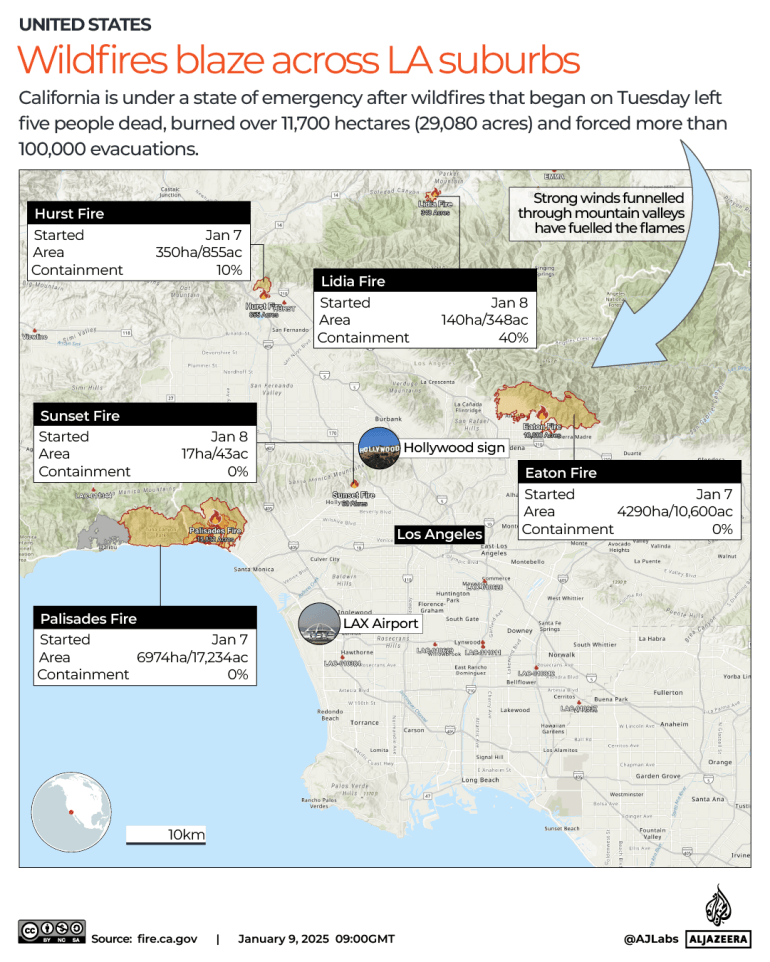In wildfires that have ravaged several areas of Los Angeles, California’s most populous state, at least five people have died and thousands of homes have been destroyed.
More than 130, 000 residents in different neighbourhoods of Los Angeles city have been ordered to evacuate as the fires, which erupted on Tuesday, continue to rapidly spread, fuelled by high winds.
So how big are the fires at present, and how did they begin?
What started the California wildfires?
According to the California Department of Forestry and Fire Protection (Cal Fire), the first fire broke out on Tuesday at 10:30 am (18:30GMT) in Los Angeles’ Pacific Palisades neighborhood.
Although it’s still not known exactly what caused the worst firestorm in recent memory, a number of factors may have contributed to the creation of ideal conditions for a fire.
Wildfires typically occur in June and July in California, which can last until October, but this one defied the calendar this year, erupting in January, the coldest of the winter months.
The fires’ location in Southern California has experienced drought conditions and intermittent rain. According to the US drought monitor, less than 4% of California was affected by drought last year and nearly 60% this year.
According to a report from the US Environmental Protection Agency (EPA), the frequency, duration, and burned area of wildfires have increased as a result of climate change.
Thus, the wildfires were most likely caused by dry conditions, which were aided by Santa Ana winds, which are common in the area.
The dry desert air travels offshore and along the coast. Due to the dry nature of the environment, which significantly reduces humidity, it contributes to wildfires. Due to this, vegetation becomes extremely dry and susceptible to fire. Under these circumstances, any spark can start a fire, be it from a cigarette butt, vehicle or power line.
Gusts up to 100mph (160km/h) were recorded at higher elevations on Tuesday night, according to AccuWeather meteorologist Danielle Ehresman.
Los Angeles is home to other flammable materials, including wooden telephone poles and low-hanging power cables.
In the past, Santa Ana winds have been linked to severe wildfires in California, including the Woolsey fire in November 2018, which claimed three lives and destroyed 1,600 structures.
Experts, however, warn that weather conditions are dire this year.
On a livestream on Monday, Daniel Swain, a climate scientist at the University of California, Los Angeles, stated that “we really haven’t seen a season as dry as this one following a season as wet as the previous one.”
How big are the California wildfires?
Rapid spread
The fire started in the Pacific Ocean’s Palisades, where it quickly spread to other neighborhoods. The second fire broke out in Eaton at about 6pm (02: 00 GMT) on Tuesday. The Hurst fire, which is located northwest of Los Angeles in Sylmar, also erupted on the same day.
Five more fires broke out in California on Wednesday: the Lidia, Sunset and Woodley fires in Los Angeles, the Olivas fire in Ventura and the Tyler fire in Riverside.
Amount of land burned
As of Wednesday night, Cal Fire reported the following is the current state of the major fires:
- Palisades: At least 6, 970 hectares (17, 234 acres)
- Eaton: At least 4, 290 hectares (10, 600 acres)
- Hurst: At least 346 hectares (855 acres)
- Lidia: At least 140 hectares (348 acres)
- Sunset: At least 17 hectares (43 acres)
The Woodley fire burned 30 acres (12 hectares) of land while the Olivas and Tyler fires both burned 11 acres (4.5 hectares) each.
Before and after the Palisades fire, the Pacific Coast highway was compared to the aerial images shown here.
Altadena was present both before and after the Eaton fire.
Containment
The perimeter or containment line that firefighters have built around the fire to stop it from spreading further is known as the containment percentage. Any physical barrier surrounding the fire, such as a dirt-dived shallow trench, can serve as a containment line.
California’s fires are barely contained, which means there is no way to stop them from spreading further. The Palisades, Eaton and Sunset fires are all zero percent contained, while the Hurst fire is 10 percent contained and the Lidia fire is 40 percent contained.
The Woodley, Olivas and Tyler fires are 100 percent contained, according to Cal Fire.

What has the government’s response been?
According to the local firefighting department, the fires’ scale has increased exponentially.
On Wednesday night, California Governor Gavin Newsom reported in an X-post that 7,500 firefighters are currently stationed.
According to the White House, US President Joe Biden canceled a planned trip to Italy in order to concentrate on the fire’s response.
Biden claimed that his team had provided ten firefighting helicopters and five air tankers on his X account. However, the strong winds have hindered aerial rescue efforts.
According to Los Angeles County Fire Chief Anthony Marrone, firefighters from Nevada and six other states were being rushed to California right away. Additionally, 250 engine companies with 1, 000 personnel were being moved from Northern California to Southern California.
However, scarce resources are.
Some fire hydrants have dried up because of water shortages in the Palisades.
Pacific Palisades depends on three tanks, each with about a million gallons (3.78 million litres), according to Janisse Quinones, the head of the Los Angeles Department of Water and Power. Quinones added that refilling water tanks at higher elevations was posing a challenge due to the demand for water to extinguish fires at lower elevations.
The Los Angeles Fire Department (LAFD) has issued evacuation orders for Hollywood, Hurst and the Palisades. The interactive evacuation map for LAFD can be viewed by clicking here.
What’s next?
Winds have weakened to about 30-50mph (50-80km/h), but fires are still active.
Unfortunately, winds are expected to pick up speed on Thursday night and Friday morning. These will not be as powerful as the winds that put out the fires on Tuesday and Wednesday.
Source: Aljazeera

Leave a Reply